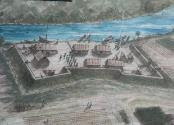 |
| Site of the Scott Massacre of 1817 |
On November 30, 1817, a U.S. army boat carrying 40 soldiers, 7 women and 4 children was attacked by Creek and Seminole warriors on the Apalachicola River in Florida. Remembered today as the Scott Massacre, the battle took place 194 years ago today.
A critical event in American history, the battle took place durign the initial days of the First Seminole War. On November 21st and 23rd, Major General Edmund Pendleton Gaines had sent troops from Fort Scott in Georgia to attack the Lower Creek village of Fowltown (Tutalosi Talofa). Located atop a commanding bluff on the Flint River, the fort stood in what is now Decatur County, Georgia. Fowltown lay about 12 miles away at a site also somewhere within the limits of Decatur County.
The chief of Fowltown was Neamathla, a man who would figure prominently in the founding of Tallahassee and the early history of Florida as a U.S. Territory. In 1817, however, he lived on land that his ancestors had claimed for as long as anyone could remember. The name Neamathla is a corruption of the Hitchiti term "Eneah Emathla" which means roughly "Fat Warrior" or "Large Warror." The chief was not a Muskogee, as many Creeks are called today, but instead spoke the Hitchiti language common among the Lower Creeks. Hitchiti is similar too, but not mutually intelligible, with Muskogee.
 |
| 19th Century Drawing of the Scott Massacre |
Trouble developed when Neamathla told officers at Fort Scott that he had no intention of giving up his land as required by the terms of the Treaty of Fort Jackson. That treaty had ended the Creek War of 1813-1814 and forced upon the Creeks the session of a vast area of territory as reparation for the expense the United States had gone through to wage the conflict. Neamathla, however, had not been a party to the treaty and therefore did not feel himself bound by it.
To overcome his "reluctance," as he termed it, General Gaines had ordered the raids on Fowltown for the purpose of bringing the chief back to Fort Scott. The raids failed to achieve that objective, but sparked two sharp battles that outraged most of the Lower Creek and Seminole warriors living along the border between North Georgia and South Florida.
While these events were underway, a large boat was making its way down and then back up the Apalachicola River under Lieutenant Richard W. Scott. An officer in the 7th U.S. Infantry, Scott had been sent down the river from Fort Scott to assist supply boats then making their way up the river. When Scott reached the supply flotilla, however, its commander took 20 of his able bodied men and then loaded Scott's boat with an equal number of sick soldiers, as well as seven women and four children. The latter individuals were family members of soldiers at Fort Scott.
 |
| Apalachicola River at Battle Site |
The lieutenant then started back upriver and, despite warnings from Chief John Blunt and others at what is now Blountstown, ordered his men to continue to pull their oars. By the afternoon of November 30, 1817, they were approaching what is now Chattahoochee, just below the confluence of the Chattahoochee and Flint Rivers at the state line.
A strong current was flowing and Scott was forced to navigate his boat close to the east or Gadsden County shore in order to keep making headway. He was unaware, however, that several hundred Creek and Seminole warriors were hiding there. As the boat came close enough, they opened fire.
 |
Later home of Elizabeth Stewart
Fort Gaines, Georgia |
The lieutenant and most of his able-bodied men went down in the first fire. The warriors then waded into the river and stormed the boat, slaughtering the men, women and children on board. When the smoke cleared, 44 of the 51 people on Scott's boat were dead. Six of the soldiers escaped by leaping overboard and swimming away under water. Four of them were wounded in the process. The only other survivor was Elizabeth Stewart. She was taken prisoner by the Indians and carried away into the forests.
When news of the battle reached Washington, D.C., outraged leaders ordered Major General Andrew Jackson to Florida with an army. His orders gave him authority to invade Spanish Florida in order to punish the perpetrators of the attack and destroy the power of the Creek and Seminole alliance in what are now the Panhandle and Big Bend regions of Florida.
To read more and to learn what happened to Elizabeth Stewart, please visit
www.exploresouthernhistory.com/scottsmassacre1.




















